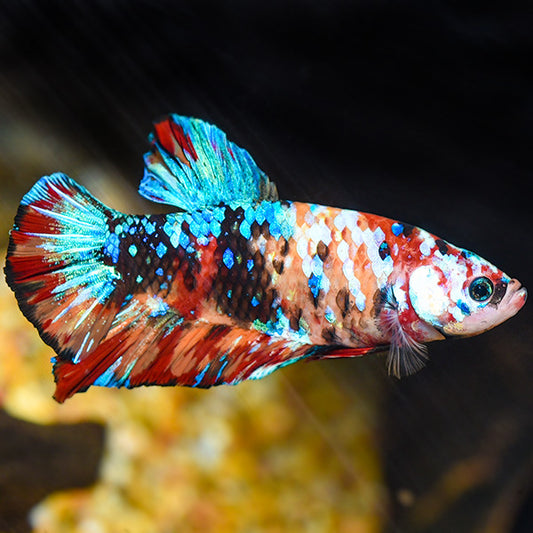Just How to Present Betta Fish to a Neighborhood Storage Tank Safely
Just How to Present Betta Fish to a Neighborhood Storage Tank Safely
Blog Article
Exactly How to Reproduce Betta Fish Effectively: Expert Strategies and Insights for Hobbyists Wanting To Expand Their Betta Collection
Reproducing Betta fish requires a nuanced understanding of genetics and ecological problems, making it essential for hobbyists to approach the procedure with both persistance and treatment. Creating an ideal reproduction setting, selecting the best pairs, and observing the ins and outs of their courtship actions are foundational steps that can considerably influence the end result.
Understanding Betta Fish Genetics
Comprehending the genes of Betta fish is critical for successful breeding, as it influences qualities such as shade, fin form, and actions. Betta fish show a varied array of colors and patterns, mostly identified by their genetic makeup. The main genetics in charge of coloration include the "B" gene for blue, "D" gene for red, and the "C" gene for shade strength. Dog breeders can adjust these traits by picking certain moms and dad fish that show desired qualities.
Along with coloration, fin morphology is one more significant aspect of Betta genetics (betta fish). The shape and dimension of fins are influenced by various genes, including those that identify whether the fins are short, long, or veil-shaped. Comprehending these hereditary variants aids dog breeders forecast the phenotypic end results of their children
Moreover, behavior characteristics such as aggression and territoriality can likewise be affected by genetics. These habits play an important function in the breeding procedure, as they can influence spawning success and the overall personality of the resulting fry. By thoroughly comprehending these genetic concepts, dog breeders can make informed choices, eventually enhancing their reproduction programs and accomplishing desirable outcomes.
Preparing the Breeding Setting
Developing an optimum breeding environment is essential for the successful reproduction of Betta fish. The very first step in preparing this setting is to select an ideal breeding tank, preferably ranging from 5 to 10 gallons. This size permits adequate swimming room and the facility of areas. The storage tank needs to be equipped with a heating unit to preserve a stable temperature level in between 78 ° F and 80 ° F, which is crucial for motivating spawning behavior.
Following, take into consideration using a sponge filter or an air stone to offer mild water blood circulation without developing strong currents that can stress the fish. It is necessary to mount plants or reproducing cones to supply concealing spots and promote comfort for the female during the spawning process. Floating plants, such as Java moss or water sprite, can likewise produce a much more natural atmosphere while promoting bubble nest structure by the man.
Prior to presenting the reproducing sets, ensure the water is conditioned and without damaging chemicals, such as chlorine or heavy metals. betta fish. Regular water changes should be conducted to maintain optimum water top quality, boosting the opportunities of effective breeding. With these preparations in position, the reproducing setting will certainly support the health and wellness and well-being of both Betta fish
Selecting Reproduction Pairs
Choosing the right reproduction pairs is critical for accomplishing successful Betta fish recreation. Healthy Betta fish exhibit lively colors, clear eyes, and active actions.
Character is another important factor to consider, as Betta fish are understood for their aggressive nature. It is suggested to choose a male and woman that exhibit compatible personalities to lessen tension Click Here throughout the breeding process. A tranquil male can urge a smoother courtship, while a woman that is also hostile might interrupt the process.
Hereditary background additionally plays a significant role in the high quality of the offspring. Reproducing fish that are genetically varied can minimize the risk of genetic health and wellness issues and boost the overall vitality of the fry. It is helpful to research the family tree of both the male and lady, focusing on desirable attributes such as fin type, color scheme, and dimension.
The Reproduction Process
The reproduction procedure of Betta fish requires cautious preparation and focus to detail to make sure a successful result. Originally, it is vital to prepare an appropriate reproduction container, preferably a 5-10 gallon aquarium with a temperature preserved at 78-80 ° F. The container should be geared up with a heating unit, filter (ideally sponge kind to stay clear of strong currents), and a lot of aquatic plants for the female to hide.
Once the atmosphere is set, introduce the selected reproducing pair to the storage tank, permitting them to accommodate. Observe their behavior; the male will display elaborate courtship rituals, consisting of flaring his fins and constructing a bubble nest. If the lady reveals rate of interest, she will show vertical stripes indicating preparedness for spawning.
When the lady is receptive, the set will certainly engage in a breeding accept, see page during which the male feeds the eggs. Preserving ideal water problems during this duration is necessary for the advancement of healthy and balanced Betta fry.
Taking Care Of Betta Fry

Feeding Betta fry is important, as they need a diet regimen high in healthy protein. They can be fed infusoria or liquid fry food, transitioning to finely crushed top notch pellets as they expand. Feed tiny portions multiple times a day to encourage healthy development without straining the container with leftover food.

As they develop, monitor their top article development closely and divide any type of aggressive people to avoid harm. By giving a nurturing setting and appropriate nutrition, hobbyists can successfully elevate Betta fry into vivid, healthy fish, inevitably enhancing their reproduction endeavors.
Verdict
Successful Betta fish reproduction needs thorough focus to genetic selection, environmental problems, and treatment for the fry. By understanding the genetics of Betta fish and preparing a suitable reproduction setting, hobbyists can enhance the chances of creating dynamic, healthy spawn.
Report this page